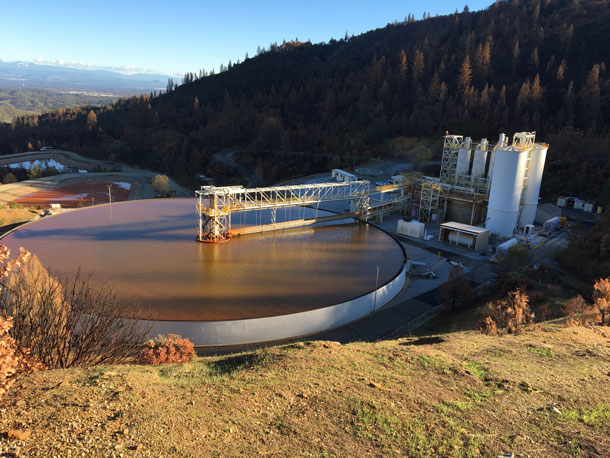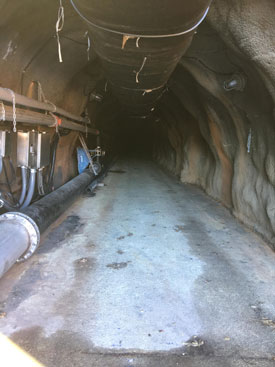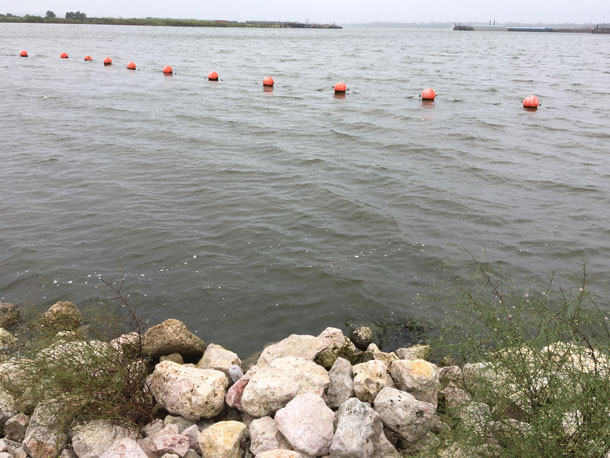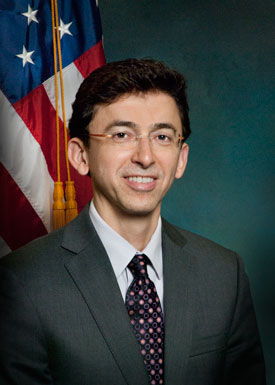Climate and Superfund Sites
Air Date: Week of December 13, 2019

The Iron Mountain Site near Redding, California is one of the three sites the Government Accountability Office physically tested for this study. This photo shows a partially constructed water treatment system by Aventis, the company responsible for contamination at the site. This water treatment system captures the acid mine drainage, neutralizes it, and removes metals prior to discharge. (Photo: Courtesy of GAO)
The U.S. has more than 1,300 Superfund sites, areas contaminated with toxic substances, and the Environmental Protection Agency is responsible for overseeing their cleanup. But a recent study conducted by the U.S. Government Accountability Office found that cleanup efforts at 60 percent of Superfund sites could be compromised by climate change disasters such as flooding, fires, and hurricanes. Alfredo Gomez, the Director of Environmental Protection at the GAO, joined Host Steve Curwood to discuss this study and the recommendations the watchdog agency made to the EPA to protect Superfund sites from the impacts of climate change.
Transcript
CURWOOD: Back in 1980 in the wake of the toxic dumping scandal at Love Canal, in upstate New York, Congress enacted a law that forced industry and property owners to cleanup places containing hazardous materials. And if there were no identifiable owners, Congress created a Superfund to set aside taxes to pay for such cleanups. Forty years later there are more than fifteen hundred Superfund places in the US, in the form of industrial sites, landfills, abandoned mines and military bases, all loaded with substances hazardous to human health. The Environmental Protection Agency is in charge of cleaning them up and remediating the dangers, and now the risks include climate change. The Government Accountability Office recently found more than half of these toxic waste sites are vulnerable to the effects of climate disruption, including wildfires, hurricanes, sea level rise, and flooding. Alfredo Gomez is director of Environmental Protection at the GAO, and led the study. Alfredo Gomez, welcome to Living on Earth.
GOMEZ: Thank you for having me.
CURWOOD: Now, from my understanding, you folks physically tested some of these sites. Where were these located? And what did you find?

In 2018 there was a California fire that almost destroyed the Iron Mountain site water treatment system. During that fire season, polyethylene pipes that carry acid drainage from one of the mines to the water treatment system were partially replaced with nonflammable stainless-steel pipes. If fire were to reach the body of the mine, there could be an explosion and various environmental health hazards. (Photo: Courtesy of GAO)
GOMEZ: We specifically visited three sites. We visited a site in the Houston area, we visited a site in Northern California that was a former mining site, and then we also visited a former industrial site in New Jersey. So we wanted to look and see what was happening at that site, what the cleanup is, what are the potential climate impacts. And in our report, for example, we talk about the mining site in California, that the officials there at EPA have told us that they're very concerned about wildfire risk. The recent wildfire there destroyed part of the site, their water treatment system that was treating acid drainage from the mine was almost affected by the wildfire. And so those are the kinds of things that we were hoping to do in this report was to bring attention to what are the potential climate effects and what may be at risk at the Superfund sites.
CURWOOD: So in 2017, Hurricane Harvey hit the Greater Houston area that had several Superfund sites. You tested one of those sites, what exactly were the substances you found there? And how much of the stuff there seemed to get out in the environment?
GOMEZ: Yes. So the Houston area, as you noted, was really affected by Hurricane Harvey. They had unprecedented flooding throughout the area. And one of the Superfund sites that we looked at in particular and visited was the San Jacinto river waste pit site, and that is a site that has past contaminants, primarily dioxins and furans. And because of the flooding that took place there, it dislodged the cap that sits at the site, and it actually released dioxins throughout the area and once EPA did testing it did find high levels of dioxin in the area. And dioxin has been shown to have adverse effects to health, for example, it does cause liver damage and certain cancers. So those are the things that are a potential risk to not only public health, but also the environment.

The San Jacinto River Waste Pit site located in Houston Texas is contaminated with dioxins and furans, exposure to which can cause several health effects including skin diseases and liver damage. This site is in an area that has 1 percent or higher annual chance of flooding that may be impacted by storm surge during Category 1 hurricanes. In 2017 Hurricane Harvey flooded this site exposing some of the contaminated material. (Photo: Courtesy of GAO)
CURWOOD: What level of concern did you find in these areas where you were testing, both by the government agencies that are in charge of this but also in the community?
GOMEZ: So there is concern from government agencies. In the Houston area, we talked to community representatives who have been concerned about proper treatment of the contaminants at that waste site. So for example, in the San Jacinto River site, the EPA has asked the responsible party now to dredge the contaminated soil and treat it off site because of the concern of future flooding at the site that might continue to disperse it.
CURWOOD: So I gather that the Government Accountability Office has made several recommendations now to the Environmental Protection Agency in the wake of this study, what were those recommendations?

Alfredo Gomez is Director of the Natural Resources and Environment at the U.S. Government Accountability Office, an independent non-partisan agency of the US Congress. (Photo: Courtesy of GAO)
GOMEZ: Yes, the first recommendation we made was that EPA needed to develop a schedule to better define the boundaries of the Superfund sites. So currently, we don't have complete information or accurate information on the actual boundaries of the sites. And part of the reason is because contamination can migrate. So for example, if the groundwater is contaminated and there is a plume, that plume can move, and so contamination can be dispersed. So that was the first recommendation we made. EPA agreed to continue working on developing better and complete information for the boundaries of the Superfund sites. We made three additional recommendations, which the agency disagreed with. Two of those recommendations are sort of similar. We recommended that EPA provide information to all of its regional offices, which is where the work is taking place to help people incorporate information on climate change impacts into their risk assessments, but also into their risk management decisions. The last recommendation was making sure that EPA is aligning the actions that are taking place, for example, at the regional offices with all the way up to the highest levels of the Superfund program. And what we talked about is that in the current strategic plan for EPA, they don't mention climate change. We wanted to make sure that there is consistency across EPA, and that everyone is able to have the information that they need to better plan for the future.
CURWOOD: Alfredo Gomez is the director of Environmental Protection at the Government Accountability Office. Thank you so much for taking the time with us today.
GOMEZ: Thank you for asking me to be a part of your show.
Links
Eco Watch | “945 Toxic Waste Sites at Risk of Disaster from Climate Change”
The Salt Lake Tribune | “GAO: 60 Percent of Superfund Sites at Higher Risk in Climate Change”
Living on Earth wants to hear from you!
Living on Earth
62 Calef Highway, Suite 212
Lee, NH 03861
Telephone: 617-287-4121
E-mail: comments@loe.org
Newsletter [Click here]
Donate to Living on Earth!
Living on Earth is an independent media program and relies entirely on contributions from listeners and institutions supporting public service. Please donate now to preserve an independent environmental voice.
NewsletterLiving on Earth offers a weekly delivery of the show's rundown to your mailbox. Sign up for our newsletter today!
 Sailors For The Sea: Be the change you want to sea.
Sailors For The Sea: Be the change you want to sea.
 The Grantham Foundation for the Protection of the Environment: Committed to protecting and improving the health of the global environment.
The Grantham Foundation for the Protection of the Environment: Committed to protecting and improving the health of the global environment.
 Contribute to Living on Earth and receive, as our gift to you, an archival print of one of Mark Seth Lender's extraordinary wildlife photographs. Follow the link to see Mark's current collection of photographs.
Contribute to Living on Earth and receive, as our gift to you, an archival print of one of Mark Seth Lender's extraordinary wildlife photographs. Follow the link to see Mark's current collection of photographs.
 Buy a signed copy of Mark Seth Lender's book Smeagull the Seagull & support Living on Earth
Buy a signed copy of Mark Seth Lender's book Smeagull the Seagull & support Living on Earth

